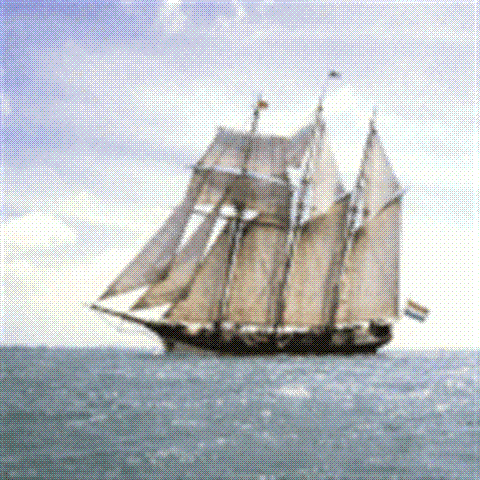 HISTORY OF COGNAC
HISTORY OF COGNAC
BY CAROL DUFF STAFF WRITER
Cognac may have its origins from as early as the first portion of the third century AD when the Roman Emperor Probus gave his approval for the production of this liquor and the privilege of the rights of possession of the vineyards to all the Gauls. The grapes for juice used to produce the cognac were from the Saintonge vineyards. The product of the distilled white wine that becomes cognac is called the eaux-de- vie or the water of life. The first vine is thought to have been planted on Rhone’s plain, and by the fourth century would spread to all of France.The Dutch and other europeans wished to compete with the English in the wine market and two new wine-growing regions were established.
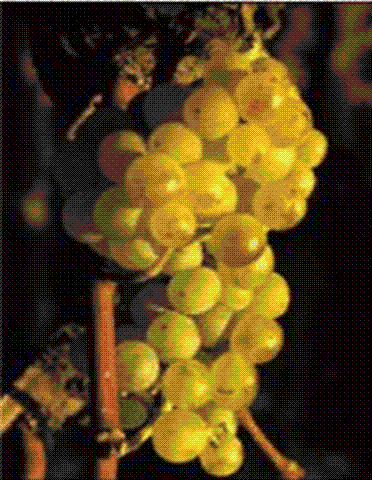 One of these regions was that of Bordeaux in the south and this later became the Gers vineyard (Armagnac) and had its access to the sea at the Adour basin. The other region was in Charentes (Cognac) which is located north of Bordeaux and had the availability of transportation of its products on the Charente River or from the port of La Rochelle. The Charente River, which was easy to navigate, was one of the factors for the success of Cognac being able to trade as it offered easy access to the Atlantic Ocean. The soil and climate of this region were very conducive for wine growing. The of Cognac had a solid interest in trading and they had a product that traded well. Wine was the substitute for water which could not be relied on to be safe for consumption. Sailors, in particular, relied on adequate wine supplies.
One of these regions was that of Bordeaux in the south and this later became the Gers vineyard (Armagnac) and had its access to the sea at the Adour basin. The other region was in Charentes (Cognac) which is located north of Bordeaux and had the availability of transportation of its products on the Charente River or from the port of La Rochelle. The Charente River, which was easy to navigate, was one of the factors for the success of Cognac being able to trade as it offered easy access to the Atlantic Ocean. The soil and climate of this region were very conducive for wine growing. The of Cognac had a solid interest in trading and they had a product that traded well. Wine was the substitute for water which could not be relied on to be safe for consumption. Sailors, in particular, relied on adequate wine supplies.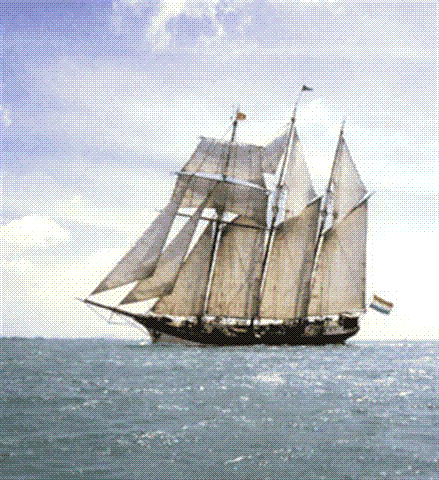
The Dutch arrived at Charente to obtain its famous Champagne and Borderies vintages. During the 17th century, the Cognacais started the process of double distillation which allowed the very concentrated alcohol to travel in the most economical conditions, namely a decreased cargo volume which was cheaper to transport. By this time the French government had instituted large taxes on the export of alcoholic drinks. When the brandy reached its destination it was mixed with water and given the name Brandywine. This brandy was kept in casks and someone noticed that it improved with age and could be drunk dry.
This was the birth of cognac.
THE BIRTH OF
COGNAC
The Cognac region was mainly Protestant and with the Edict of Nantes guaranteeing freedom of worship and faith the people felt safe. The Sun King, Louis the 14th, cancelled the edict and these Protestant families were forced to leave. They emigrated to England, Ireland, or Holland and began to import the product that their relatives in the Cognac region worked so hard to produce. This helped to establish the export network that eventually included the West Indies, North America, and Indian Ocean Islands. Principal regional cities and trading posts were founded in the 17th and 18th centuries.
By the end of the 19th century phylloxera had reached the Cognac region, but after a short time this area became the leaders in replanting until they were the largest producers of France’s white wines. The Charentais had to re-establish and open new markets throughout the world. They endeavored to protect against Cognac’s imitators and guarantee quality and maintain the region’s global economy
Now 20,000 winegrowers, on slightly more than 80,000 hectares in the Charente and Charente-Maritime, produce cognac. This region is further divided into the Grande Champagne, Petite Champagne, Borderies, Fine Bois, Bon Bois, and Bois Ordinaries. Appellations for cognac is of little importance because most cognacs are mixtures of different origins. The millesimes, or year of birth, is far less important than for wine because the cognac ceases to mature after it is placed into a sealed glass container. In actuality the law forbids putting a date on most cognac because the label would describe the youngest eaux-de-vie in its blend. In addition, the words “chateau” and “domaine” are rarely used because the blendings of eaux-de-vie do not originate from one specific place. Vines are planted with nine foot spaces between to allow for maximum exposure to the sun.
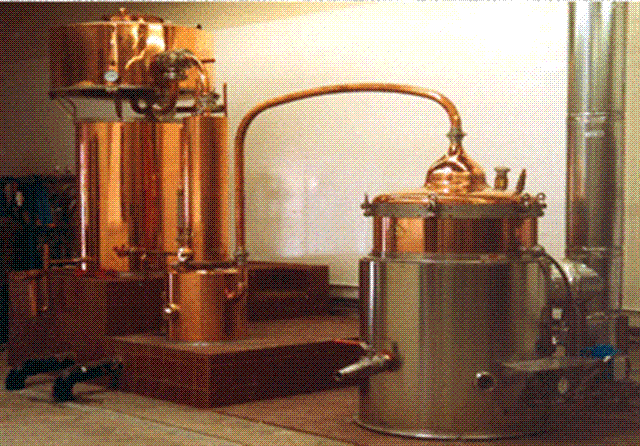 Grapes are picked once a year, at the beginning of October, and although some growers still pick their grapes by hand, most use machines. All cognacs originate from Cognac and its surroundings which included two French departments specifically Jarnac and Segonzac. In 1909 there was a decree that claimed that only spirits made with the eaux-de-vie from the protected zone and those grapes that were allowed were entitled to use the Cognac name. The distilling and aging must follow specific techniques including double distillation in a copper alembic still and aging in oaken barrels for a minimum period of time. All cognac is not brandy and not all brandy is cognac.
Grapes are picked once a year, at the beginning of October, and although some growers still pick their grapes by hand, most use machines. All cognacs originate from Cognac and its surroundings which included two French departments specifically Jarnac and Segonzac. In 1909 there was a decree that claimed that only spirits made with the eaux-de-vie from the protected zone and those grapes that were allowed were entitled to use the Cognac name. The distilling and aging must follow specific techniques including double distillation in a copper alembic still and aging in oaken barrels for a minimum period of time. All cognac is not brandy and not all brandy is cognac.
The Charente valley has a tempered sea climate, large amounts of sunlight, and a rich clay soil that are all favorable for cultivating the vines. The decree of 1936 and 1939 divided the province of Cognac into six regions. These regions were determined by the value of the soil. In 1850 a geologist, Coquand, discovered that there was a definite influence of the soil on the quality of the eaux-de-vie. By 1909 the French government had fixed the official limits of the province of Cognac. The soil in this province is light lime stone on the surface and thick subsoil which regulates the amount of moisture during periods of drought or rain. This kind of soil is called “champagne.”
REGIONS OF
PRODUCTION OF COGNAC
The Charente River had six different crus or viticultural areas. Each region produces a different quality of eaux-de- vie as the areas form a circular belt surrounding Cognac and the eaux-de-vie gain body and lose sharpness as they move further from the center. Grande Champagne Grande Champagne is at the center of the Cognac region and produces the most celebrated eaux-de-vie with a floral bouquet that is light and fine. The town of Gegonzac is the Capital of the Grande Champagne. These wines require a long aging period to attain maturity. Petite Champagne Petite Champagne is the semi-circle that surrounds the Grand Champagne and its eaux-de-vie also has a floral bouquet which comes from soils that are under more influences of the maritime climate and are thus considered to lack the finesse of the Grande Champagne.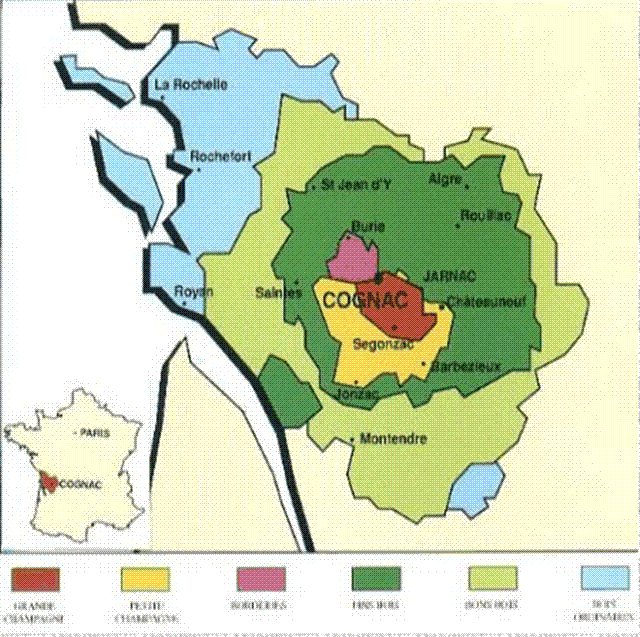
The combination of the blend of the Grande and Petite Champagne, containing at least 50 percent of the Grand Champagne, may bear the title of Fine Champagne. Borderies North of Cognac is Borderies which is the smallest of the six crus. This region produces highly rated eaux-de-vie. These brands are fine, smooth and have a slight nutty or violet aroma and are used to enrich other eaux-de-vie to produce cognac. They require a shorter aging period than the Grand Champagne. Bons Bois and Fins Bois The Bons Bois is the outer boundary of the Cognac area, while the Fins Bois completes the loop around the initial three crus, which leaves them more exposed to the ocean climate. The cognacs from this region mature faster, are smooth, and their aroma is that of freshly pressed grapes. Bois Ordinaires’ The Bois Ordinaires’ come from a sandy earth that lies next to the sea. They have a roughness and a fast maturing, fruity eaux-de-vie.
By the 12th century William X, Duke of Guyenne, opened the huge wine territory called Vignoble de Poitou. The Dutch ships, which brought salt across the Northern Sea to Poitou, returned to their homeland with wines of this area. By the 16th century France had become the main producer and exporter of wines in all of Europe. The Dutch ships carried wines from the areas of Champagne and Borderies back to their ports.
It is said that the vineyards of Aunis produced such a large quantity of wine that it was problematic to transport and the low alcoholic wines became ruined after long ocean voyages. The wine would spoil if transported to warm countries. This would later be solved by the process of distillation which was used only rarely at this time. The wine trade has been developed from the port of Bordeaux since the Middle Ages. When Alienor of Aquitaine married Henry Plantagenet the Guyenne went to the English who established a monopoly of wine production in Aquitaine in the 18th century.
DISTILLATION
PROCESS
Usually the grape variety, Ugni Blanc, is used for the production of Cognac. This white wine grape is chosen for its late maturation and ability to resist disease. This varietal comprises 98 percent of the Cognac vineyards. Some Colombard and Folle Blanche are also used. These grapes produce a thin white wine that is considered good only for cognac. The harvests, which are usually during the month of October, are immediately pressed in the traditional horizontal plate in pneumatic presses. The continuous presses, using the Archimede’s screw press are not allowed. After three weeks of fermentation, using no additives such has sugar, the acidic wines have a low volume of alcohol, usually about 8 percent. At this time they are ready for distillation.
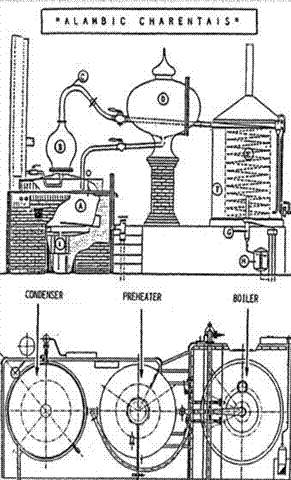
The art of cognac making is a very complex process and it never results from a single eaux-de-vie or growing area. There is always blending of different ages and crus, perhaps as many as one hundred of them. The blending is left to the cellar master who is responsible for upholding the brand’s taste. He oversees all; from the purchase of the eaux-de-vie to the ageing, and the blending. Each house guards its own secrets of blending and assembling the eaux-de-vie. The process of distillation is based on the differences between various chemical components. Typically with distillation only the lighter substances that make up the main features of the bouquet remain. The initial distillation process forms white wine into Eaux-de-vie. The distillation of the eaux-de-vie allows the concentration of the bouquet of the wine and the delicate aromas. The main technique of distillation for cognac is the use of the second distillation. Only the middle portion of the distillate, called the bonne chauffe, is retained from this second process.
The upper portion is too high in alcohol and the lower portion lacks harmony. These remains may be distilled over again in order to reach perfection. Alambic distillation is a very old technique which dates back to the Chinese in 3,000 BC. The Egyptians started to distill in 2,000 BC, the Greeks in 1,000 BC and the Romans in 200BC. In 1250, Arnaud de Villeneuve was the first to use distillation in France and produced what he called eaux-de-vie or water of life. The Cognac area uses the alembic still. The design of the still was changed to better suit distillation of the eaux-de-vie. An Eaux-de-vie can become a cognc only after a long period of maturing in oakwook casks. Since the wood is porous, the liquid stays in contact with either the humid or dry air that is in the cellars. As it rests in the cask, it loses some of its alcohol content. It is said that this evaporation leaves a dark hallow over the walls of the town. This if due to a microscopic fungus ( torula compniacensis Richon) from the humid air of the cellars.
AGING IN
BARRELS
After distillation, the cognac begins to mature at a maximum of 72 percent alcohol level. Over time one third of the alcohol will be lost, as the cognac reaches no less than 40 percent in order to be sold. The aging process follows three stages. The first stage of aging is the extraction, during which the wood transfers most of its boise’, taste, and tannin. The colorless eaux-de-vie is influenced by the tannins in the wood and the color changes to golden amber. It is up to each cognac house to determine the amount of time that the vintage remains in young (which transmits far more tannin) and old casks. This amount of time determines the quality. The second stage is the ageing, which is also called degradation or hydrolysis. This is the period in which the eaux-de-vie flattens.
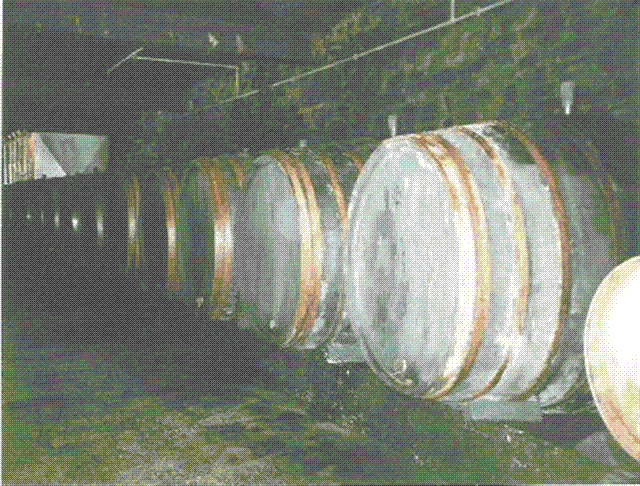
It takes two to three years of maturing for the eaux-de-vie to reach the quality that is proper for consumption. More time may be allowed for ageing, and this helps the cognac gain perfume, aroma, taste, and complexity. Cognac can age for fifty years to mellow and to reach its finest bouquet. The third stage is the oxidation which gives the eaux-de-vie its final golden shade and bouquet. Once it is placed into glass it no longer matures as it has no contact with wood or air.
The demi-john of each cognac house holds the oldest cognacs and these remote cellars are know as “Paradise.” The perfect shape of glass from which to sip cognac is the ballon or tulipe glass. These shapes allow the aroma of the cognac to rise up into the nose and concentrates the aroma while also touching the taste buds. The senses of sight, smell and taste are all used in enjoying a cognac. Cognac is placed into three basic categories and these categories are: V.S.. (very special) or that which can be sold at the age of two years V.S.O.P. (very superior or pale) or that which is at least five years of age The Napoleon and X.O. (extra old) must be at least four years old, but is usually much older. Nintey-five percent of cognac is exported with more than 200 million bottled produced in a year. The main consumers are the US, England, Germany, Japan, and Hong Kong with the Japanese consuming the most costly cognacs.
COPYRIGHT
CAROL WARE DUFF
2005

Carol graduated from Riverside White Cross School of Nursing in Columbus, Ohio and received her diploma as a registered nurse. She attended Bowling Green State University where she received a Bachelor of Arts Degree in History and Literature. She attended the University of Toledo, College of Nursing, and received a Master’s of Nursing Science Degree as an Educator.
She has traveled extensively, is a photographer, and writes on medical issues. Carol has three children RJ, Katherine, and Stephen – one daughter-in-law; Katie – two granddaughters; Isabella Marianna and Zoe Olivia – and one grandson, Alexander Paul. She also shares her life with her husband Gordon Duff, many cats, and two rescues.
ATTENTION READERS
We See The World From All Sides and Want YOU To Be Fully InformedIn fact, intentional disinformation is a disgraceful scourge in media today. So to assuage any possible errant incorrect information posted herein, we strongly encourage you to seek corroboration from other non-VT sources before forming an educated opinion.
About VT - Policies & Disclosures - Comment Policy



